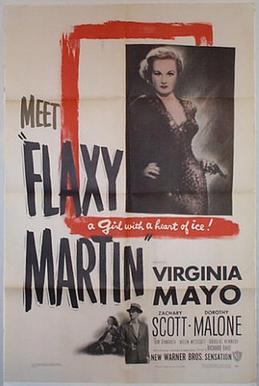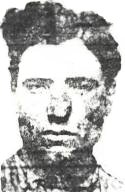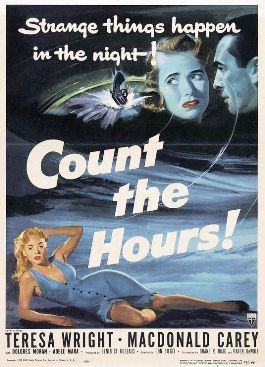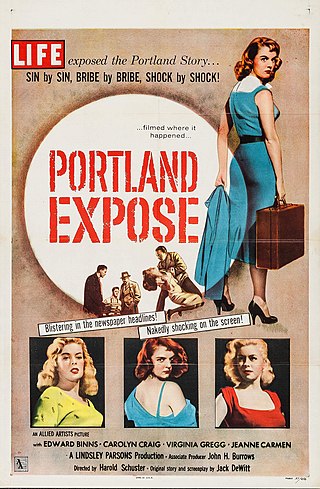
John Donato Torrio was an Italian-born American mobster who helped build the Chicago Outfit in the 1920s later inherited by his protégé Al Capone. Torrio proposed a National Crime Syndicate in the 1930s and later became an adviser to Lucky Luciano and his Luciano crime family.
The Irish Mob is a usually crime family-based ethnic collective of organized crime syndicates composed of primarily ethnic Irish members which operate primarily in Ireland, the United States, the United Kingdom, Canada and Australia, and have been in existence since the early 19th century. Originating in Irish-American street gangs – famously first depicted in Herbert Asbury's 1927 book, The Gangs of New York – the Irish Mob has appeared in most major U.S. and Canadian cities, especially in the Northeast and the urban industrial, including Boston, New York City, Philadelphia, Pittsburgh, Baltimore, Cleveland, and Chicago.

Flaxy Martin is a 1949 film noir starring Zachary Scott and Virginia Mayo, and featuring Elisha Cook Jr., Dorothy Malone, and Douglas Kennedy. The crime thriller was directed by Richard L. Bare based on a story written by David Lang.

Red Light is a 1949 American film noir crime film directed and produced by Roy Del Ruth, starring George Raft and Virginia Mayo, and based on the story "This Guy Gideon" by Don "Red" Barry, featuring strong religious overtones.

The Mob is a 1951 American film noir crime-thriller produced by Columbia Pictures, directed by Robert Parrish, and starring Broderick Crawford. The screenplay, which was written by William Bowers, is based on the novel Waterfront by Ferguson Findley.

The Long Wait is a 1954 American crime drama film noir directed by Victor Saville starring Anthony Quinn, Charles Coburn, Gene Evans and Peggie Castle. The film is based on the 1951 novel of the same title by Mickey Spillane. It was an independent production distributed by United Artists.

The Atlantic City Conference held between 13–16 May 1929 was a historic summit of leaders of organized crime in the United States. It is considered by most crime historians to be the earliest organized crime summit held in the US. The conference had a major impact on the future direction of the criminal underworld and it held more importance and significance than the Havana Conference of 1946 and the Apalachin meeting of 1957. It also represented the first concrete move toward a National Crime Syndicate.

D is a 2005 Indian Hindi-language crime thriller film directed by Vishram Sawant, co-written by Manish Gupta and Ram Gopal Varma. Produced by Varma and Ronnie Screwvala, it was released in India on 3 June 2005. It is the third film in the Gangster film series.

The Los Angeles crime family, also known as the L.A. Mafia or the Southern California crime family, and dubbed "the Mickey Mouse Mafia" by former Los Angeles Police Chief Daryl Gates, is an Italian-American organized crime syndicate based in Los Angeles as part of the larger Italian-American Mafia. Since its inception in the early 20th century, it has spread throughout Southern California. Like most Mafia families in the United States, the Los Angeles crime family gained wealth and power through bootlegging alcohol during the Prohibition era. The L.A. family reached its peak strength in the 1940s and early 1950s under Jack Dragna, although the family was never larger than the New York or Chicago families. The Los Angeles crime family itself has been on a gradual decline, with the Chicago Outfit representing them on The Commission since the death of boss Jack Dragna in 1956.

Count the Hours! is a 1953 crime film noir directed by Don Siegel, featuring Macdonald Carey, Teresa Wright, John Craven, and Jack Elam.

The Case Against Brooklyn is a 1958 film noir crime film directed by Paul Wendkos, starring Darren McGavin and Margaret Hayes, and based on the True Magazine article "I Broke the Brooklyn Graft Scandal" by crime reporter Ed Reid. The film features depictions of American police corruption, though no police officer in uniform is shown to be corrupt.

New York Confidential is a 1955 film noir crime film directed by Russell Rouse starring Broderick Crawford, Richard Conte, Marilyn Maxwell, Anne Bancroft and J. Carrol Naish. Produced by Edward Small for release by Warner Bros., the film was inspired by the 1948 book New York: Confidential! by Jack Lait and Lee Mortimer.

Mob City is an American neo-noir crime drama television series created by Frank Darabont for TNT. It is based on real-life accounts of the L.A.P.D. and gangsters in 1940s Los Angeles as chronicled in John Buntin's book L.A. Noir: The Struggle for the Soul of America's Most Seductive City. The series premiered on December 4, 2013.

Barnett "Barney" P. Ruditsky was a British-born American police officer and private detective.

King of the Underworld is a 1939 American crime drama film starring Humphrey Bogart as a gangster and Kay Francis as a doctor forced to treat him. It was directed by Lewis Seiler. It is a remake of the 1935 film Dr. Socrates, which was based on a short story by W. R. Burnett.

The Gangster Squad, later known as the OrganizedCrime Intelligence Division (OCID), was a special unit of the Los Angeles Police Department (LAPD) formed in 1946 to keep the East Coast Mafia and organized crime elements out of Los Angeles.

Dolores Dorn was an American film and television actress, who was the co-star of The Bounty Hunter (1954), Uncle Vanya (1957), Underworld U.S.A. (1961), and several other films through 1985. On Broadway, she was billed as Dolores Dorn-Heft.

Flight to Hong Kong is a 1956 American crime film noir directed by Joseph M. Newman and starring Rory Calhoun, Barbara Rush, Dolores Donlon. The film was co-produced by Newman's Sabre Productions and was the first of Rory Calhoun's Rorvic Productions. It was the feature film debut of Werner Klemperer.

Strange Alibi is a 1941 American crime film directed by D. Ross Lederman, written by Kenneth Gamet, Leslie T. White and Fred Niblo Jr., and starring Arthur Kennedy, Joan Perry, Jonathan Hale, John Ridgely, Florence Bates and Charles Trowbridge. It was released by Warner Bros. on April 19, 1941.

Portland Exposé is a 1957 American film noir directed by Harold Schuster and starring Edward Binns and Carolyn Craig. The plot follows a tavern owner in Portland, Oregon who is involved in a struggle for power between two gangs attempting to control the unions. The film was inspired by crime boss Jim Elkins and the McClellan Committee's investigation into Portland's underground criminal ventures in the 1940s and 1950s, which were the subject of an extensive article published in Life magazine in March 1957.



















